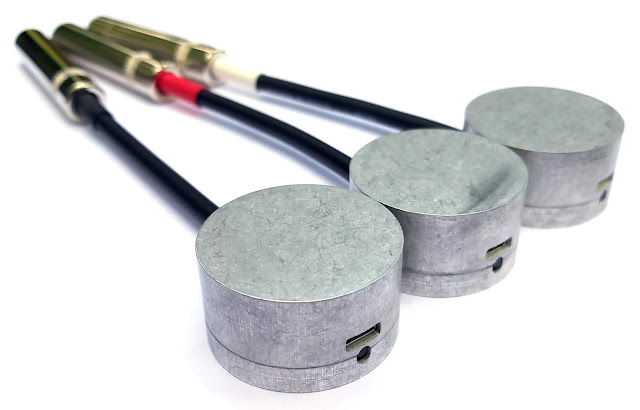Digital Textiles
Introduction
Anyone within earshot knows, and is already sick of the fact, that I have been obsessed with knitting and crochet for the past few months. I bought a knitting machine and have been knitting everything from scarves to topological manifolds to non-euclidian surfaces. I've been looking at knit art-installations, Daina Taimina, amigurumi, the hyperbolic crochet coral reef project, and yarn bombing. I convinced myself that knit fabric cannot exist in any dimension other than 3 and that knit fabric, despite the etymology, is topologically not a knot. I re-read Alan-Turing's seminal paper on the Entscheidungsproblem to try to determine if knitting is Turing-complete (I'm still not sure). And I have been trying to design an anti-knitting machine that can annihilate with a knitting machine.
Figure 1: Some random things I knit (including a Klein bottle on the right).
Conductive Yarn
And then I discovered conductive yarn, and it blew my mind. Conductive yarn is mostly synthetic yarn with some steel fibers embedded in it. The steel fibers are only a few microns in diameter, thinner than human hair, and you would not notice that the yarn contains metal. Conductive yarn differs from conductive thread in that thread is always conductive and is essentially (with caveats) a replacement for copper wire, whereas yarn is mostly non-conductive unless it is stretched taught or smashed so that the steel fibers are brought into close contact with one another. So conductive yarn does not does not act as a wire, but can be used to make pressure and stretch sensors.So I bought some conductive yarn from Uppingham Yarn. It is 80% polyester and 20% steel.

Figure 2: Conductive Yarn from Uppingham Yarn.
Although it has the electrical properties of conductive yarn and not conductive thread, it has a diameter and sartorial properties of thread. I didn't have a multimeter here with me in the UK and it was the middle of the night, so I just went ahead and knit some of this thread into fabric, alongside some regular synthetic yarn.

Figure 3: A failed experiment with conductive yarn knit into fabric alongside regular yarn.
In the morning I spent about 4 hours trying to track a multimeter down at work, which you would think would be easy given that I work in a an engineering department at a university, but due to the usual excessive bureaucracy and power-mongering I eventually gave up and bought one for £8. To my disappointment, but not entirely my surprise, I learned that my fabric is completely non-conductive. In fact, when not under tension, the yarn I bought shows infinite resistance over even just a centimeter of length. That drops to perhaps 1 kΩ per centimeter when stretched to the point of breaking, which does not require that much force.
So I decided to try making some multi-ply twine. The process I used to do so is depicted in Figure 4 and the completed twine is in Figure 5.

Figure 4: I spun the thread-sized yarn into yarn-sized twine by a) stretching 16 plies of yarn out across the largest space I could find; b) attaching a pencil to one end and twisting the plies together somewhat tightly; c) folding the entire length of twisted 16-ply in half for a total of 32 plies, and putting the other end on the same pencil, and d) carefully releasing the tension from the whole thing and letting the two halves twist themselves together.

Figure 5: Completed 32-ply twine.
The completed twine has very roughly a few kΩ of resistance over a 10 centimeter segment when loose, and that drops by very roughly an order of magnitude when stretched firmly taught. There is a large amount of variability in the resistance when loose (ranging from 1kΩ to 10s of kΩ for 10 centimeters), but there is always a sharp and immediate decrease or increase when the tension changes.
Knit Conductive Fabric
This twine can be knit quite easily on a circular knitting machine -- I have an Addi Express Kingsize. Since the twine is not even slightly elastic, I feed the yarn into the machine with no tension at all, and I go slowly and check that the needles are not splitting the plies, and it goes quite well.
Figure 6: Knitting a flat panel of conductive twine (and regular wool yarn) on a circular knitting machine.

Figure 7: Detail of machine-knit conductive fabric.
Knit sensors
I made a pressure sensor by sandwiching a 9x9 stitches rectangle of conductive fabric between two knit wool pieces of the same size. The wool gives the whole sensor some extra bounce. The result is in Figure 8.Figure 8: Knit pressure sensor with a layer of conductive fabric between two layers of worsted-weight wool fabric.
I made a stretch sensor by knitting a 7x16 stitches (3.8 meters of twine) rectangle with a similar amount of acrylic yarn knit onto each end. The acrylic gives the whole sensor a little extra springiness. The result is in Figure 9
Figure 8: Knit stretch sensor comprising a rectangle of knit conductive twine (gray) with acrylic yarn (black and white) knit onto both ends.
I started trying to make a knit x-y position sensor. I made 2 flat panels. Each panel is made by alternating 2 rows of wool yarn (100% merino -- the purple I picked up in Switzerland and the blue in London) with 1 row of conductive twine. 2 is the minimum number of intermediate rows that are needed to prevent successive conductive rows from touching, although I'm not sure that this matters. I put the two panels on top of one-another oriented at 90 degrees with respect to each other so that the conductive rows form a grid. The result is in Figure 9.

Figure 10: Knit x-y position sensor showing conductive rows (gray) between non-conductive wool rows (blue and purple). Underneath and out of sight is another identical layer that is oriented at 90 degrees to the top visible layer, so that the bottom conductive rows form a grid with the top ones.
The drop in resistance is somewhat more subtle than I had hoped, but I think it is still detectable. A multimeter isn't quite sufficient for seeing how well the position sensor works as a whole. I ordered an Arduino which I'll be able to use to measure all of the conductive rows at the same time. I have a few theories about how to improve on this design, but I'll have to wait for my Arduino to arrive before I can make any more progress.



Darn! I didn't see that coming!
ReplyDeleteI can see this looming over the horizon.....
ReplyDelete